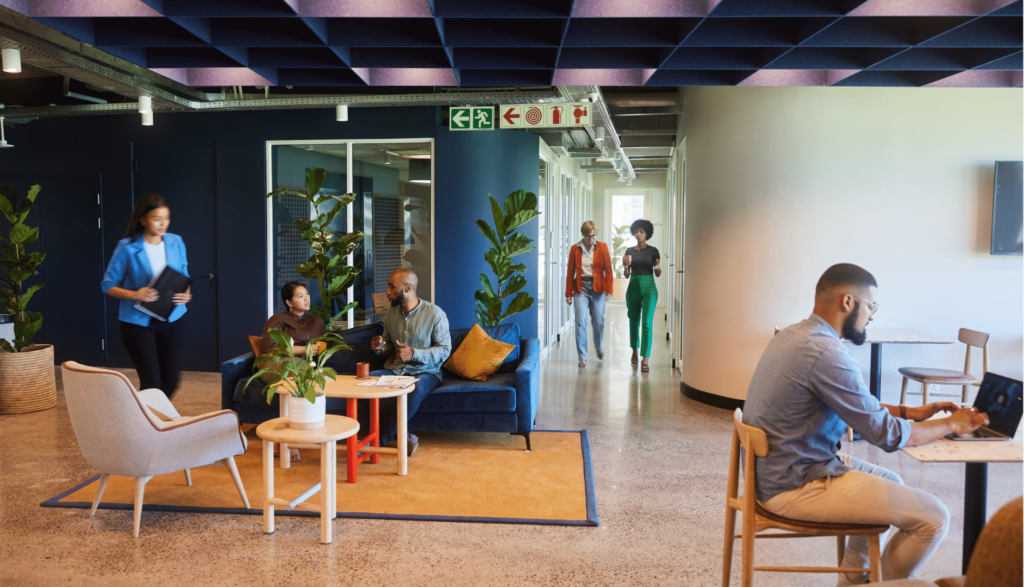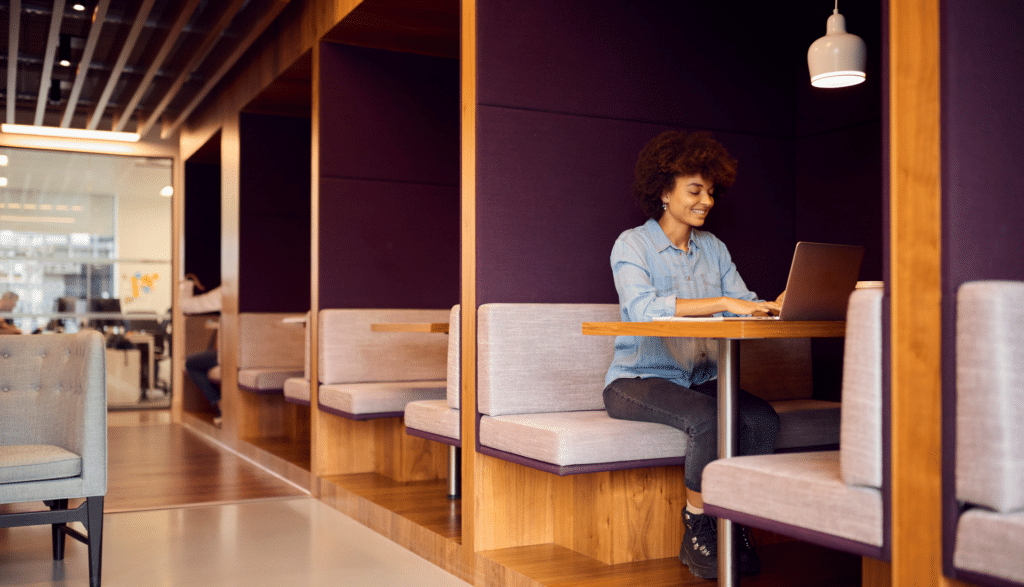Hot desking. Desk booking. Hybrid workplaces. Dynamic seating. Office Hoteling. Office real estate is changing, and the language is changing with it. In this article, we’ll be exploring the concept of hot desking, how it can benefit the hybrid office, how to navigate potential challenges, and how to utilize dynamic and interactive desk booking software to efficiently organize your workspaces.
Hot Desking Defined
Simply put, hot desking involves using an “unassigned” desk system in a designated office. With hot desking, desks, and meeting rooms are booked on a first-come, first-served basis, based on desk availability. Employees often book on-site or use desk booking software to reserve desks for a given period, as needed.
While hot desking has become a popular concept in the post-pandemic work environment, it’s hardly a new concept. Hot desking began getting popularized in the 1990s, touted as a revolutionary, futuristic, and fresh way to look at workspace utilization. Well, the future has arrived. Hot desking has become a staple of the hybrid work environment, with 52% of employers surveyed indicating they would be open to alternative space utilization models such as hot desking and room booking in their office space.
Interestingly, the term hot desking derived from the Navy term “hot racking,” where Navy Seals slept in shifts and traded out beds where the bed would still be warm for the next person. The Navy developed this method to utilize their space and time efficiently, which is exactly how the system serves the modern workplace. By introducing a flexible approach to space management, businesses can make the most of their real estate while giving hybrid teams additional options for desk utilization.
Benefits of Hot Desking
Hot desking provides unique opportunities that are not as accessible in fixed-office spaces or to fully remote employees. With hot desking and other desk reservation models, you can expect to see:
Increased employee engagement
With hot desks, hybrid teams have the opportunity to meet and collaborate in person, making it easier to feel more connected to the company and one another. When team members correspond only via email, Slack, or Zoom, they can feel isolated and disconnected from their peers. Seeing one another and sharing physical space helps encourage collaboration, strengthens existing relationships, and fosters community engagement.
Cost efficiency
A smaller office means real estate savings. In a hybrid hot-desking environment, all your employees won’t be in the office at once. By streamlining your space utilization to accommodate different schedules and office occupancy rates, you can reduce the square footage of your office to only what you need, lowering your real estate and facility costs.
Flexible work
With numerous work styles, personalities, and motivations in a workforce, it can be challenging to provide a flexible work environment that prioritizes all your employees’ well-being. Introverted employees may thrive working solo, while more sociable employees may work best when they can bounce ideas off one another. Some employees may love having their home office, while others may not have housing situations conducive to working remotely.
That’s where desk booking solutions like hot desking come in. They provide a flexible avenue for an employee to work in a designated area beyond their personal space. Companies that implement hot desking provide their employees with the flexibility and autonomy to achieve maximum productivity and comfort.
Cleaner workspace
Because successful hot desking means better desk management, a cleaner office space naturally follows. The typical expectation is “leave no trace,” which means removing evidence that the desk was used at all. The person who uses the desk will leave it as they found it, maintaining a cleaner overall office environment. By having a tidy workspace, less money and time will be dedicated to janitorial and other building services, saving facility managers money.

Hot Desk Critiques
While hot desking has many benefits, there are concerns about how hot desking can impact an office that must be addressed for successful implementation. Common hot desking challenges include:
Distractions
While hot desking can help some team members avoid distractions, it can have the opposite effect on others. The unpredictability of working near a peer an employee hasn’t met before or seen in a long time can take time away from the employee using their time in the office efficiently.
While there is the potential for impromptu meet and greets to occur, acknowledging this concern also recognizes the opportunity for cross-company collaboration and employee engagement. Surprise meetings can also be managed by using desk booking software like OfficeSpace. With greater transparency about who will be in the office and when an employee who knows they are easily distracted can take steps to adjust their schedule to avoid potential interference.
More IT resources
While there might be less space being utilized and a smaller real estate footprint, the need for a readily available IT employee might require extra resources. Desk booking systems, interactive office maps, smart workstations, interactive floor plans, and other technological workplace management advances require setup, and someone will need to manage their functionality on-site.
Less personalization
Some people like to work at their permanent desks and don’t like the idea of changing locations frequently. Their desk may have a photo of their pet or family member, their favorite pencil holder, or their ergonomic keyboard that lights up yellow when you press the keys.
You won’t find that with hot desk booking, and that can be a struggle for those who like to personalize their space. This can be avoided by encouraging team members to bring the items that assist them in their productivity with the knowledge that they will have to take them home when they leave.
Hot Desking Today
While room booking was commonly used pre-pandemic, with in-office or online booking processes being fairly common, desk reservation strategies like hot desking and desk hoteling have become incredibly popular post-pandemic.
As companies are transitioning back into office spaces after leaning solely on remote work for two years, they are embracing hybrid work models, which require unique strategies, functionalities, and solutions to work efficiently and provide a positive and productive employee experience.

What is hybrid work?
The definition of a hybrid office is a working model where some work time is spent on-site and some time is spent working remotely. This has gained recent popularity, as the pandemic illustrated that employees could work from home and keep up with their workloads.
Why choose the hybrid model?
The hybrid office is popular for for the flexibility and freedom it provides employees, but requires significant organization and office management to achieve success. Here are a few benefits and key features of the hybrid work model.
Ideal candidates
Hybrid work is one of the most popular forms of work from an employee standpoint, and 68% of people surveyed globally prefer the hybrid style of work. With the majority of workers favoring the hybrid work model, a company providing hybrid work will have a better selection of candidates and will attract the best employees.
Meeting Room Optimization
Space utilization metrics help organizations optimize the use of meeting rooms and conference rooms. By understanding how and how often meeting rooms are used, organizations can adjust the number and size of meeting spaces to meet demand more effectively.
Happier employees
Work-life balance improves employee experience. Employees who are satisfied with their work will have more pride in the work they do. By using a hybrid work model, employees can achieve a better work-life balance by having the autonomy to work from home or the office.
Critiques of Hybrid Work
There are several known challenges to the hybrid work model. Communication breakdowns can occur more often. If people aren’t in the office together at the same time, it can be difficult to communicate effectively through Slack or Zoom. Space utilization can also be an issue, as an office might have unused or underutilized space the company still pays for.
However, tackling these issues with the correct structures, systems, and tools is possible. Companies are creating tighter forms of communication within their organization and using new technologies to collaborate with remote workers.
Through better data collection and analysis, businesses can implement things like hot desking, room booking, and other space utilization practices that allow them to make the most of their offices or find ways to reduce their real estate, saving money.
Advantages of hot desking and room booking in the hybrid office
Hot desking and room booking are great ways to address the issues that can arise in hybrid teams. If a workplace has unused space, instead of investing in an expensive renovation, a business can downsize real estate costs or adjust the layout to increase the spaces employees use. This can reduce rent and transform the office into a more efficient use of space.
Room and desk booking tools also allow hybrid companies to collaborate in innovative ways. It can strengthen communication amongst hybrid employees, as it lends space for employees to meet in person with and across teams. Cross-company cohesion is critical in creating a foundation for employee satisfaction, and giving co-workers the ability to coordinate their work environment around their schedules can promote loyalty and employee engagement.
Solving the challenges of hot desking in the hybrid workplace
Distractions
One common issue with hot desking is sometimes a person might be sitting next to a group of co-workers who are having a meeting while they are trying to focus on their work. Trying to find a balance between the sound activity in the office is an important consideration when navigating hybrid seating vs. hot desking.
What is the solution to these potential issues? Data. By identifying how certain areas are used through check-ins, employee badging, WiFi logins, and other data sets, businesses can use that data to create an office layout that strikes a balance between collaborative meeting rooms, quiet desk areas, and other office features based on what employees use.
When implementing hot desking, finding out the needs of the different employees and developing a layout that works for them is an integral part of creating a functional hybrid environment. Using desk booking software can provide a lot of much-needed transparency to the employees coming into the office. Team members can see what spaces are available to better plan their day or week based on their specific needs in the office.
Space issues
In some offices that use hot desking, there have been cases where employees show up and there are not available desks, as hot desks are available on a first-come, first-served basis. With hot desk booking tools like OfficeSpace’s desk booking software, you can bypass this issue and save your employees precious time. The employee can use the software to see the available desks in the office and book desks before their arrival.
Using Desk Booking Software
Hot desking software like OfficeSpace can help you understand the needs of your employees and address organizational complications quickly and efficiently. By utilizing the data and analytics provided by a data-driven desk booking and meeting room booking system, you can identify trends and make informed office organizational decisions to improve the workplace experience.
Setting up seating arrangements
With hot desk booking software like OfficeSpace, you can assign seating captains and desk permissions to navigate seat allocations. This can be helpful when setting up neighborhoods in your office. By using desk booking software, you can allow seating captains to have control of the neighborhoods, ensuring that those desk spaces are being used efficiently and correctly.
Forecast future demand
Using the data provided through user hubs, you can identify the times employees are using the office and how they navigate the layout. With this data, you can make changes to the office arrangement and downsize or upscale as needed.
Understand employee trends
OfficeSpace and other desk booking software actively monitor employee trends. Track which spaces become occupied and note the amenities identified within those spaces. It’s also possible to see if employees use various amenities regularly, such as standing desks. You can record their needs based on the data and analytics shown by their seating choices.
Using desk booking software to identify seating trends will provide the information you need to apply efficient hybrid space utilization tactics like hot desking while maintaining employee satisfaction, comfort, and productivity.
Book a demo with OfficeSpace software today and start streamlining productivity, lowering costs, and improving your workplace experience.




